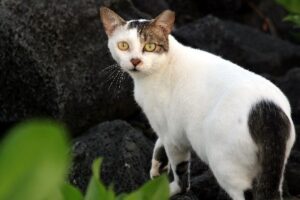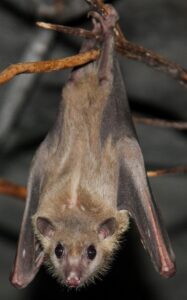Introduction
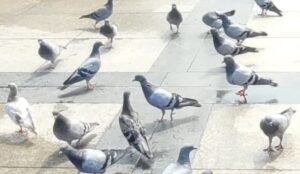
Birds are immeasurably valuable to humans and the environment. People enjoy watching, feeding, and conversing with harmless and beautiful birds, even common city pigeons, sparrows, and starlings. These birds represent a few of the only naturally free forms of wildlife. Unfortunately, these same birds can be nuisances and may then fly to nearby urban areas to roast and nest (or rest, but this has nothing to do with breeding or feeding) on and in buildings such as food warehouses, restaurants, apartment building windowsills, school and hospital rooftops, and the like.
Urban birds may play potentially important roles in food-borne illness outbreaks, and may frequent livestock fields that contain livestock manure, urine, molds, soil, fungi, bacteria, and viruses (Salmonella, Cryptococcosis, Histoplasmosis, Avian influenza, Ornithosis, and Pigeon Fancier’s disease). These birds also contaminate food and deface buildings, signs, statues, vehicles, and other items of importance in urban environments.
Like other pest management programs, ETS provides an effective bird management program that incorporates several management approaches. Sanitation, exclusion or habitat alteration, repellents, and population reductions are the essential components of managing urban pest birds.
When a public relations program is warranted, ETS technicians always inform and consult all public officials before beginning the management program. This helps keep all concerned parties informed that only nuisance birds will be controlled.
Three common bird pests are found in the UAE:
- Pigeon (Rock Dove) – Columba livia Gmelin – (Columbudae: Columbiformers)
- European Starling – Strurnus vulgaris Linneaus – (Sturnidae: Passeriformes)
- House Sparrow – Passer domesticus (Linneaus) – (Passeridae: Passeriformes)
- Pigeon (Rock Dove):
General Description

- Pigeons have gray bodies with a whitish rump, two black bars on the secondary wing feathers, a broad black band on the tail, and red feet.
- The body color can vary from gray to white, tan and blackish.
- The average weight is about 300-400g, and the average length is 30 cm.
Life Cycle and Common Characteristics
1. Reproduction:
- Pigeons are monogamous (i.e., they have one mate at a time).
- The male cares for and guards the female and the nest.
- It reproduces in the 4-6th month and broods 2-3 times a year.
- The female lays 1 or 2 eggs after 8 to 12 days of mating.
- Eggs hatch after 18 days.
- The squabs are fed a secreted substance called pigeon milk.
- The young are raised for 4-5 weeks by the parents. More eggs are laid before the first young are weaned.
- Breeding may occur during all seasons, but peak reproduction is in the spring and fall.
- The population consists equally of males and females.
- Wild pigeons can live for 15 years, and sometimes longer.
- In typical urban environments, however, most pigeons do not live for more than about three-and-a-half years.
- This bird is a resident.
2. Habits and behaviors:
- The pigeon is the most serious urban bird pest in the UAE.
- They frequent parks and sidewalks, feeding on food provided by people.
- They use city bridges and buildings that provide roosting, loafing, and nesting sites. They also inhabit farmyards, livestock facilities, grain elevators, feed mills, and other buildings.
- In cities, pigeons tend to move in flocks of several hundred, which frequently move about, fly, and roost together.
- Occasionally, a smaller group will select a house or a few houses on which to roost, but in general, they prefer large buildings.
- Pigeons inhabit roofs, ledges, drain spouts, lofts, steeples, caves, and ornate architectural features of buildings where openings allow for roosting, loafing, and/or nest building.
- Pigeons do not construct a typical bird nest. Instead, their nests consist of sticks, twigs, and grasses and are built in the crevices of rocks.
3. Feeding: − Pigeons feed mainly on grains and seeds, as well as snails and spittle.
- An adult pigeon consumes about 1 lb. of food per week.
- The ingested food is digested with the aid of gravel or sand, which serves to grind food in the gizzard, or digestive organ.
- Pigeons must have water.
- Healthy pigeons can exist for several days without food, but they require water each day.
- Resting, nesting, and roosting sites are frequently located in protected areas up high on structures.
2- European Starling:
General Description
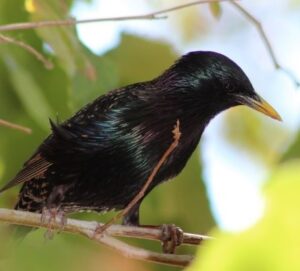
- The starling is a stocky, short-tailed bird about the size of the robin. From a distance, it appears entirely black, but it is actually flecked with light speckles.
- Most of its feathers show iridescent purples and greens.
- The bill of both sexes is yellow during breeding season (January to May), and dark for the rest of the year.
- Juveniles are a plain brownish-gray.
Life Cycle and Common Characteristics
1. Reproduction:
- Starlings mate in the spring.
- Females lay 4 to 7 greenish-blue eggs without spots.
- Eggs hatch after 12 to 14 days of incubation.
- The young leave the nest when they are about 21 days old.
- Both parents help build the nest, incubate the eggs, and feed the young.
- Usually, two broods hatch per season.
- By the end of the breeding season, it is formed by thousands of birds that roost collectively on reeds, trees, or buildings.
- Partially considered a migratory bird. Migrate in February, March, and October.
2. Habits and behaviors:
- They travel in flocks, as do pigeons and sparrows.
- Nests are usually built in wide open towns, in meadows, fields and sides of streams. They situate their nests in areas such as tree cavities and in almost any available hole in and around buildings.
- In city and suburban areas, starlings are pests because they use buildings, parks, and residential trees for roost sites.
- Feces from large numbers of starlings on and around the trees will kill the trees.
- Starlings spend the warm weather months in rural areas. In colder weather in the fall, they descend in large flocks into towns and cities at night to seek the warmth and shelter of large buildings.
- Feeding:
- During the daylight hours, winter urban starling flocks feed at feedlots or grain elevators and fly back to the protected city roost sites at night.
- Each day, they may fly 15 to 30 miles between roost sites and feeding sites.
- Starlings consume a variety of foods (insects, worms, spittle, snails, fruits, seeds, and scraps) that make up a large portion of their diet during the breeding season.
- During the winter months, waste from food-processing facilities makes up a substantial part of their diet.
- In times of food scarcity, starlings will feed on almost anything to survive.
- House Sparrow:

General Description
- The house sparrow is small and has a stocky appearance.
- The upper parts are reddish brown streaked with black, and the under parts are gray.
- The female and immature birds lack any distinctive markings.
- The male has a characteristic black throat, gray crown, and chestnut-colored nape.
Life Cycle and Common Characteristics
1. Reproduction: − The female lays 3-9 eggs speckled with dense black-brown spots.− The incubation takes place for 14 days. − It takes care of feeding the chicks for 11 to 17 days.
- The young are fledged (ready for flight) at about 14 days.
- House sparrows can produce up to 5 broods per year.
- The high reproductive rate is offset by an annual natural mortality rate ranging between 40 and 60%, often depending on the severity of the winter.
2. Habits and behaviors:
- House sparrows can inhabit virtually every part of a city, nesting and/or perching in and around all types of residential and commercial buildings.
- Flocks of house sparrows can be serious nuisances.
- In rural areas, they are destructive around poultry and other livestock operations as they consume and contaminate large amounts of livestock feed.
- They are also capable of destroying building insulation.
- Large flocks often develop around food-serving establishments, shopping malls, warehouses, stadiums, and airport hangers.
- In residential areas, sparrows are pests in gardens and around yards, where they frequently displace desirable songbirds.
- The nests of house sparrows are usually built in, on, or near buildings.
- The nests are typically messy and are comprised of twigs, grass, and paper.
- Sparrows will also nest in trees and shrubs, usually using the same nesting locations and tree cavities year after year.
- Sparrow nests constructed on and around power lines and in electrical sub-stations have caused serious fire hazards.
- Sparrows are gregarious (i.e., group-loving).
3. Feeding:
- The food of the house sparrow varies, but grain is its preferred item. They also feed on the fruits and buds of some trees and bushes, as well as green leaves.
- The average adult sparrow eats less than 1/4 oz. of food daily.
- During the breeding season, the nestlings are fed insects.
- In rural areas, sparrows thrive at cattle feedlots, dairy farms, and hog and poultry farms where food and shelter are plentiful.
- In urban locations, they depend upon human trash that provides foods such as bread, fat, and other table scraps.
Economic & Health Damage of Birds
- Economic Damage
- Some types of birds may cause economic or health damage to homes and their occupants, which puts them in the ranks of dangerous household pests. When birds, such as sparrows and pigeons, gather in large numbers on the roofs, windows, and trellises of houses and electricity poles, take positions or places of shelter, breed, and then set out to feed and return with the materials they may carry, they work on the dirt and pollution of the house.
- The excreme
 nt of these birds and the remains of their food cause stains on the walls and walls with sticky dirt, and some fungi grow on them, which in turn secrete acidic substances that cause corrosion of buildings.
nt of these birds and the remains of their food cause stains on the walls and walls with sticky dirt, and some fungi grow on them, which in turn secrete acidic substances that cause corrosion of buildings. - Damage may occur as a result of nests and dead birds gathering in air-conditioning vents or rainwater drainage. It also spoils light bulbs and causes damage to electrical connections.
- Losses are inflicted on home gardens as a result of their feeding and destruction of fruits, vegetables, and small seedlings, in addition to the disturbance they cause when they are present in large numbers, especially in the early morning and at sunset.
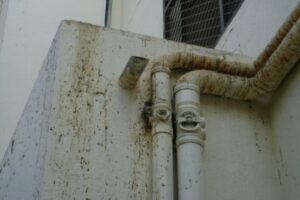
- The containment of bird droppings on ammonia and folic acid leads to the corrosion of car paint and the corrosion of metals and devices.
- Some birds and their flocks cause problems and danger to air navigation lines and airports, and collisions of some birds in the air may result in accidents, even if they are rare.

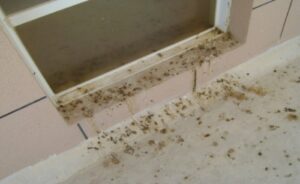
- Health Damage:
Birds can harbor disease organisms that may affect people, pets, and domesticated animals. However, reports of disease outbreaks directly linked to urban pest birds are rare, and the actual incidence of transmission of diseases from urban pest birds is difficult to assess. Diseases and ectoparasites transmitted by birds to humans are mentioned below.
| Causing Agent and Injury | Disease |
| − It is caused by a deadly strain of avian influenza (H5N1) virus.− There are cases of infection and deaths in some Asian and European countries.− The virus infects birds, especially wild ones, where the causative agent is found in its intestines, but does not make them sick, while its transmission from wild birds to domestic birds leads to their sickness and death.− The disease can be transmitted from poultry through saliva, nasal secretions, and droppings to people who work in the poultry business.− Human infection with this disease can lead to severe disease and death, and the virus strain (H5N1) is the killer that infects poultry and transmits to humans.− There is a fear of a mutation in this strain that enables the virus to be transmitted from one person to another. Because humans have not been infected with this virus previously, they do not have immunity against it, and if the mutation occurs, this will pose a threat to increasing the epidemic of the disease.− Making sure that there is an infection in one bird in a flock of poultry is important, and it is imperative to get rid of all existing birds by culling them, performing all necessary sterilization operations, and imposing a quarantine in the place where the infection was found and its surrounding places. | Avian influenza
|
| − A disease caused by the fungus Histoplasma capsulatum, which is a systemic disease transmitted to humans by airborne mushroom spores from soil contaminated with bird droppings, especially pigeons, starlings, sparrows, and some other birds.
− The soil under the perches and nests of birds carries a high percentage of bird droppings, which is a suitable medium for the causative fungus.− Inhalation of air containing fungus spores leads to infection with the disease, whose symptoms include high fever, changes in the nature of the blood, and pneumonia. Infection with the disease may also lead to blindness in the eyes, and, in most cases, death. |
Histoplasmosis
|
| − A disease caused by the fungus Cryptococcus neofarmans, which affects people after inhaling the air that contains the vegetative cells of the causative fungus, which is mainly found in pigeon droppings and to a lesser extent in the droppings of starlings and birds.− The pathogen was found in 84% of the samples that were examined from pigeon perches, and one gram of droppings contains about 50 million colonies of the causative fungus, and that the age and dryness of the droppings do not affect the vitality of the fungus.− Symptoms of infection are ulcers under the skin or lung injuries. Infection with this disease also causes severe pain in the head and a significant defect in vision.− The disease may spread to other parts of the body, especially the central nervous system, which makes it a fatal disease. | Cryptococcosis
|
| − A bacterial disease caused by Chlamydia spp. It is found in the droppings of parrots, parakeets, pigeons, starlings, and sparrows.
− The disease affects the lungs and can be cured. |
Ornithosis
|
| − This disease is caused by the bacterium Psittococcus spp. found in pigeon and parrot droppings.− The disease causes pneumonia by inhaling particles of excrement and feathers. | Pigeon Fancier’s disease
|

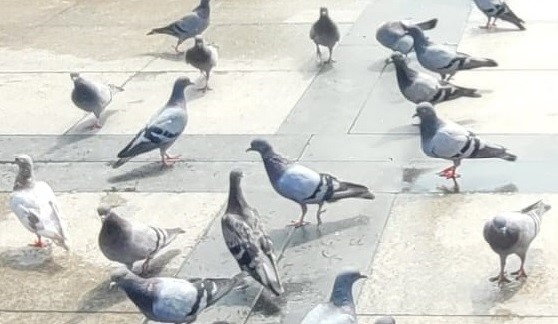
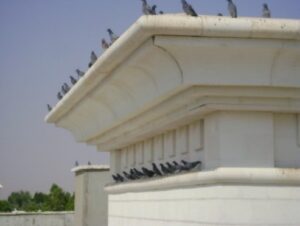 nt of these birds and the remains of their food cause stains on the walls and walls with sticky dirt, and some fungi grow on them, which in turn secrete acidic substances that cause corrosion of buildings.
nt of these birds and the remains of their food cause stains on the walls and walls with sticky dirt, and some fungi grow on them, which in turn secrete acidic substances that cause corrosion of buildings.